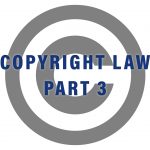Amazon sellers receive account suspensions for intellectual property violations all of the time, and most of them are not nefarious.
 Often times, an uninformed Amazon seller can violate intellectual property unknowingly. It makes no difference to Amazon; the company expects its sellers to be well versed in the law. So let’s break it down for you..
Often times, an uninformed Amazon seller can violate intellectual property unknowingly. It makes no difference to Amazon; the company expects its sellers to be well versed in the law. So let’s break it down for you..
Copyrightable Material on Amazon
Some of the most copyrightable products on Amazon are original products sold by sellers.
While many sellers list products from other companies, there are some sellers who sell their own original products on the marketplace. Those sellers likely own the copyright to their products and are therefore the rights holders of their own merchandise. If you’re the owner of such products, you’re going to be looking out for more with regards to intellectual property violations than other sellers.
The practice of selling original products is much more common on marketplaces such as Etsy, which specializes in homemade merchandise. But Amazon recently launched Amazon Handmade, which serves in a similar capacity and has brought more sellers of that ilk onto Amazon.
However, most Amazon sellers will not have to worry about having their own copyright infringed upon. Most sellers will have to watch out to make sure they’re the ones who aren’t violating intellectual property laws.
Some of the major ways in which Amazon sellers generally get in trouble with copyright issues are in ways that you wouldn’t normally think about: product images and descriptions.
Images
A product image can be pretty important for sales on Amazon. It’s the first thing that a customer will see when scanning the search pages for the product they’re looking for. An eye-capturing image can lead to many more clicks and ultimately, many more purchases.
However, images are the original property of the person or company who took the picture, unless it was a work for hire in which case it is the property of the person who ordered the image. If you sell clothing, you can’t use images of that clothing that you found online in place of the product image. You must use your own original pictures or you could get busted for intellectual property infringement, which would lead to an Amazon seller’s account suspension. And no, a screenshot of a copyrighted image does not count as your own image. That’s still copyright infringement.
If you don’t feel confident in your abilities to create quality photos for your product listings, know that there are services you can hire to take great pictures for you.
Danny Carlson from Kenji ROI spoke about the importance of quality product images on a Wednesday Webinar with CJ Rosenbaum, founder and CEO of Rosenbaum Famularo, P.C., law firm behind Amazon Sellers Lawyer:
“People really don’t like to read the listing. So the goal with the image set is you give people all of the information they need to see to know that your product is the right one for them without them having to go read through your listing and your bullet points. So images are always first and then the rest of the listing is secondary.”
Get your hands on some original product pictures and you won’t have to worry about violating Amazon’s intellectual property laws on images. It’s as simple as that.
Text
Another way in which Amazon sellers generally get in trouble is the way in which they word descriptions and bullet points for their products. Even if you’re re-selling something from another company, you cannot use the same verbiage that company uses on the product listing or you are committing copyright infringement.
As CJ Rosenbaum puts it in his book Amazon Sellers’ Guide: Copyright Law, “for example, Cannon camera drafts text describing the various features of its cameras. Cannon has copyright interest to the description of the cameras. If a seller copies Cannon’s verbiage and pastes it anyplace, the seller would be violating Cannon’s intellectual property rights.”
It’s the same thing as plagiarizing a paper in grade school: don’t do it and you won’t have to have an unpleasant conversation with the teacher after class. It’s better to receive a C on a paper than to get a 0 because you copied someone else’s work. The same is true on the Amazon marketplace when the punishment is losing the rights to sell on the platform.
Of course, writing text isn’t the easiest thing to do or people wouldn’t be using copyrighted phrases in the first place. But there are certainly some tips that sellers can use to boost their descriptions. Danny from Kenji ROI has a couple of pointers:
“With bullet points, that’s where we try to convey as much information as we can to persuade the customer. It’s important to have brevity and to be super concise. That’s one problem I always see with listings is that people make them way too long. A lot of sellers put on average 2-3 times more text than they need on there, when they could say the exact same thing in about two sentences.”
Like with images, there are plenty of services that provide sellers with expertise on crafting quality product descriptions. It’s a good idea to invest in that if you don’t feel confident in your own writing abilities.
First Sale Doctrine
Images and text are the two most common ways that sellers can get in trouble with Amazon over intellectual property. And while the creator of an original product is also in control of that product’s copyright, other sellers can still sell that creator’s product without explicit permission.
The First Sale Doctrine mandates that in the United States, you can re-sell a lawfully purchased product even if you don’t own the copyright to that product. That’s what allows some Amazon sellers to list used books, video games, and the like. We’ll get deeper into the doctrines later, but that basic rule saves Amazon sellers a whole lot of headache.
Amazon Copyright Law: Conclusion
If you want to stay out of hot water with Amazon and keep yourself in business in the online marketplace, use your own images and use your own personal descriptions of your products in your listings. If you get legitimately busted for intellectual property infringement, there’s only so much that can be done to get you back from suspension. So do your homework – become well versed in what’s allowed on Amazon and what isn’t. That way, you won’t be dealing with the consequences later.
But if you find yourself facing a suspension for an illegitimate claim, know that a well-worded Plan of Action can take you far.
 Anders is a content creator for Rosenbaum Famularo, P.C., the law firm behind AmazonSellersLawyer.com.
Anders is a content creator for Rosenbaum Famularo, P.C., the law firm behind AmazonSellersLawyer.com.
Anders recently earned his degree in journalism from Hofstra and has six years of professional journalism experience. He has written for numerous online and print publications including SB Nation and The Hofstra Chronicle.